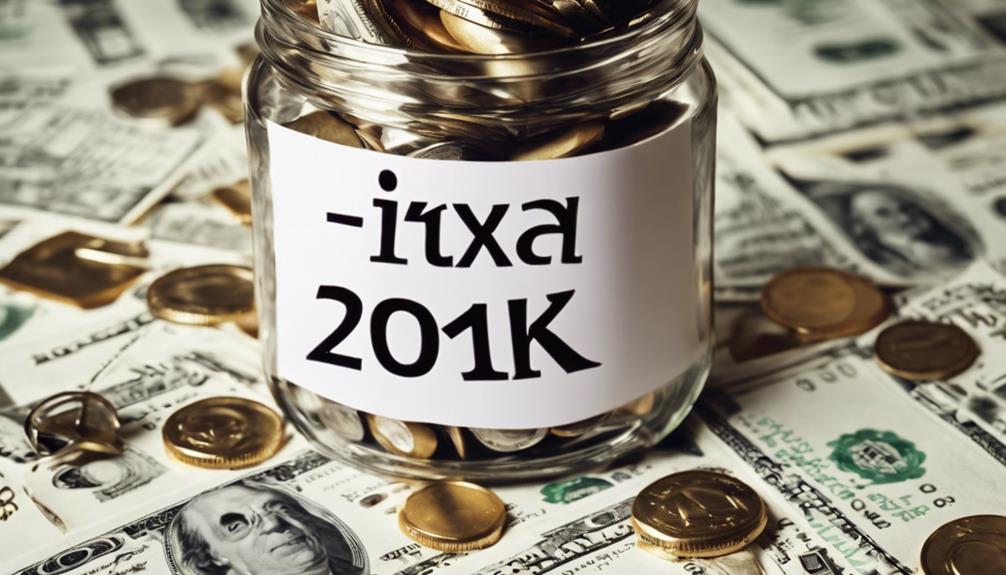Diversifying retirement plans can help increase savings potential and improve financial security. Having multiple plans provides tax advantages, diversifies investment options, and maximizes growth potential. Understanding contribution limits is crucial, with 401(k)s capped at $20,500 and IRAs at $6,000. Combining different accounts can help manage risk during market fluctuations and offer flexibility in asset allocation. Employer matches and tax benefits can further enhance savings. It is advisable to seek guidance from a financial advisor to align plans with retirement goals. By diversifying across different accounts, you can effectively navigate tax implications and ensure a prosperous financial future.
Key Takeaways
- You can have multiple retirement plans to maximize savings potential.
- Consider diversifying plans for tax advantages and investment growth.
- Contribution limits vary by plan type, allowing for increased savings.
- Managing risk through multiple plans offers protection and income stability.
- Seek guidance from a financial advisor for optimized retirement planning.
Benefits of Having Multiple Retirement Plans
To maximize retirement savings efficiently, we advocate for diversifying your retirement plans to reap various financial benefits. By having multiple retirement accounts, individuals can enhance their savings potential and guarantee greater financial security during retirement. Diversifying retirement accounts not only allows for a mix of pre-tax and post-tax contributions but also optimizes tax advantages, maximizing overall savings. Different retirement plans offer a range of investment options and growth potentials, enabling individuals to build a well-rounded portfolio that can withstand market fluctuations and economic uncertainties.
Moreover, leveraging multiple retirement plans can help individuals take full advantage of employer matches, which can greatly boost savings over time. By spreading savings across various plans, individuals can meet diverse financial goals while mitigating risks associated with relying on a single retirement account. This strategic approach to retirement planning not only provides financial security but also ensures a more robust and stable financial future.
Tax Advantages of Diversifying Plans

Diversifying retirement plans not only enhances savings potential but also maximizes tax advantages by spreading contributions across different tax treatment options. By combining traditional 401(k) plans with Roth IRAs, individuals can adopt a tax-diversified approach to their retirement savings strategy.
Traditional 401(k) contributions are made with pre-tax money, reducing taxable income during the contribution years. On the other hand, Roth IRA contributions are made with after-tax money, allowing for tax-free withdrawals in retirement. This combination provides flexibility in managing tax implications during retirement.
Additionally, incorporating Health Savings Accounts (HSAs) alongside traditional retirement plans can yield triple tax advantages specifically for healthcare expenses in retirement. This strategic utilization of different retirement accounts not only optimizes savings potential but also offers a tax-efficient way to plan for a financially secure retirement.
Strategies for Maximizing Savings Potential

When considering strategies to maximize savings potential, understanding contribution limits and the benefits of diversification is essential.
Contribution limits dictate how much you can put into each retirement account, impacting your overall savings potential.
Diversification helps protect against market volatility and can optimize your investment growth over time.
Contribution Limits Overview
Exploring the contribution limits for various retirement accounts can reveal key strategies to maximize savings potential effectively.
For 2023, 401(k) plans allow individuals under 50 to contribute up to $20,500, while those 50 and older can contribute up to $27,000.
Traditional and Roth IRAs have a contribution limit of $6,000, with a $1,000 catch-up option for individuals 50 and above.
In the case of Health Savings Accounts (HSAs), individuals can contribute up to $3,650, and families up to $7,300 per year. Those 55 and older can add an extra $1,000 to their HSA.
Leveraging the contribution limits of these tax-advantaged savings vehicles within diversified retirement plans can greatly enhance your retirement savings potential.
Diversification Benefits
To enhance our retirement savings potential, we can strategically allocate funds across various retirement plans to optimize our income streams. Diversifying our retirement portfolio through multiple plans offers a range of investment options, allowing us to spread risk and potentially maximize growth.
Each plan comes with its unique tax advantages and contribution limits, providing opportunities to save more efficiently. By leveraging the benefits of different retirement accounts, we can create a more secure financial foundation for our future. This strategic approach not only helps in diversifying our investments but also in building robust retirement income streams.
Managing Risk Through Multiple Plans

When it comes to managing risk through multiple retirement plans, diversification is key. By spreading investments across different asset classes, we can better safeguard our savings from market fluctuations.
Having various plans like 401(k), IRA, and annuities not only offers benefits and protections but also guarantees a more robust income stream during retirement.
Diversification for Risk Management
By diversifying retirement plans, we can effectively manage risk by spreading our investments across different asset classes. This strategy allows us to mitigate potential losses in one area by balancing them with gains in another, ultimately reducing overall portfolio volatility.
Diversification is key in safeguarding our funds and investing for the long term. By incorporating various retirement accounts like 401(k)s, IRAs, and annuities, we create a well-rounded approach to risk management. Each of these vehicles offers unique benefits and can help us navigate through market fluctuations and economic uncertainties.
Selecting diverse investment options within our retirement plan enables us to optimize growth potential while minimizing the impact of any single market event.
Benefits of Multiple Plans
Diversifying retirement savings across multiple plans offers enhanced risk management and increased financial security. By spreading investments across various accounts, individuals can better manage risk through diversification.
Different retirement plans come with unique tax advantages and contribution limits, allowing for higher savings potential. This strategy enables individuals to choose from a variety of investment options that align with their risk tolerance and financial goals.
Flexibility in Retirement Planning

Utilizing multiple retirement plans offers individuals the flexibility needed to optimize their savings potential and tax advantages. By diversifying your retirement savings across various accounts, you can strategically allocate funds to maximize growth and minimize tax liabilities.
Here are some key points to ponder:
- Contribution Limits: Different retirement plans have varying contribution limits, allowing you to contribute more money overall, potentially boosting your savings exponentially.
- Tax Advantages: Each plan offers unique tax benefits, such as tax-deferred growth or tax-free withdrawals in retirement, helping you save more efficiently and keep more of your hard-earned money.
- Employer Match: Taking advantage of any employer match offered in plans like a 401(k) can significantly enhance your savings without any additional contribution from your pocket.
Investment Opportunities With Multiple Plans

To maximize investment opportunities and diversification, having multiple retirement plans is advantageous. By strategically utilizing a combination of individual retirement accounts (IRAs), workplace retirement plans like 401(k)s, and health savings accounts (HSAs), individuals can access a broader range of investment options tailored to their financial goals.
Each type of plan offers unique tax advantages, such as tax deductions on contributions or tax-deferred growth, along with specific contribution limits that can vary based on the plan type and individual circumstances. Managing investments across multiple accounts allows for greater flexibility in asset allocation, risk management, and overall investment management.
Diversification across various retirement plans can help mitigate risk and enhance potential returns over the long term. To make the most of these investment opportunities, it's advisable to consult with a financial advisor who can provide guidance on optimizing your portfolio across different retirement accounts. By carefully balancing risk and return within each plan, individuals can work towards achieving their retirement savings goals efficiently and effectively.
Reviewing and Adjusting Retirement Plans

Regularly reviewing and adjusting retirement plans is essential to ensure alignment with changing financial goals and circumstances. When it comes to saving for retirement, we need to make sure our plans are on track. Here are three key steps to contemplate:
- Contribute at least the maximum match: Ensuring you contribute the maximum amount that your employer matches can greatly boost your retirement savings.
- Develop a detailed plan: Working with a financial professional to develop a thorough retirement plan tailored to your needs and goals can lead to better outcomes.
- Monitor and adjust investments: Keeping an eye on market trends and economic conditions can help you make informed decisions when adjusting your retirement plans for improved performance.
Ensuring a Successful Retirement Strategy

Creating a thorough retirement plan is vital for guaranteeing a successful financial future. By diversifying your retirement savings across multiple accounts like a 401(k), IRA, and HSA, you can take advantage of different contribution limits and tax benefits. This strategic approach allows for flexibility in managing withdrawals and minimizing tax implications during retirement.
Consulting a financial advisor is essential in developing a cohesive strategy that aligns with your retirement goals. Their expertise can help you navigate the complexities of managing various accounts to optimize savings and establish financial security in retirement.
Frequently Asked Questions
How Many Retirement Plans Can I Have?
We can have multiple retirement plans to maximize savings potential. There is no limit to the number of plans we can have, but contribution limits apply to each. Diversifying investments and understanding rules is essential.
What Is the 4 Rule for Retirement Savings?
We follow the 4% rule – a safe guideline for withdrawing retirement savings yearly. This rule, backed by historical data, aims to guarantee sustainable withdrawals. Adjustments are key based on circumstances and market conditions for financial security.
Is It Good to Have Multiple Retirement Plans?
Having multiple retirement plans is advantageous. Diversifying savings offers security and flexibility. Different accounts maximize tax benefits and savings potential. We can tailor our strategies, manage risks, and guarantee a stable financial future through varied investments.
What Is the 10X Retirement Rule?
The 10X Retirement Rule advises saving 10 times our annual income for retirement. It offers guidance for achieving financial security later in life, taking into account expenses like healthcare and housing. Following this rule can help us plan effectively. By adhering to the 10X Retirement Rule, individuals can work towards ensuring they are financially prepared for unforeseen costs that may arise during retirement, such as inflation or extended life expectancy. Retirement savings longevity explained, this approach ensures that savings last throughout the entirety of retirement by building a substantial financial cushion. Additionally, it encourages consistent saving habits early in life to maximize long-term growth through investments.
Conclusion
In the symphony of retirement planning, having multiple plans can harmonize your savings strategy and help you reach your financial goals.
By diversifying your investments and taking advantage of tax benefits, you can maximize your savings potential and guarantee a successful retirement.
Stay informed, stay proactive, and keep adjusting your plans as needed to orchestrate a secure and fulfilling future.











